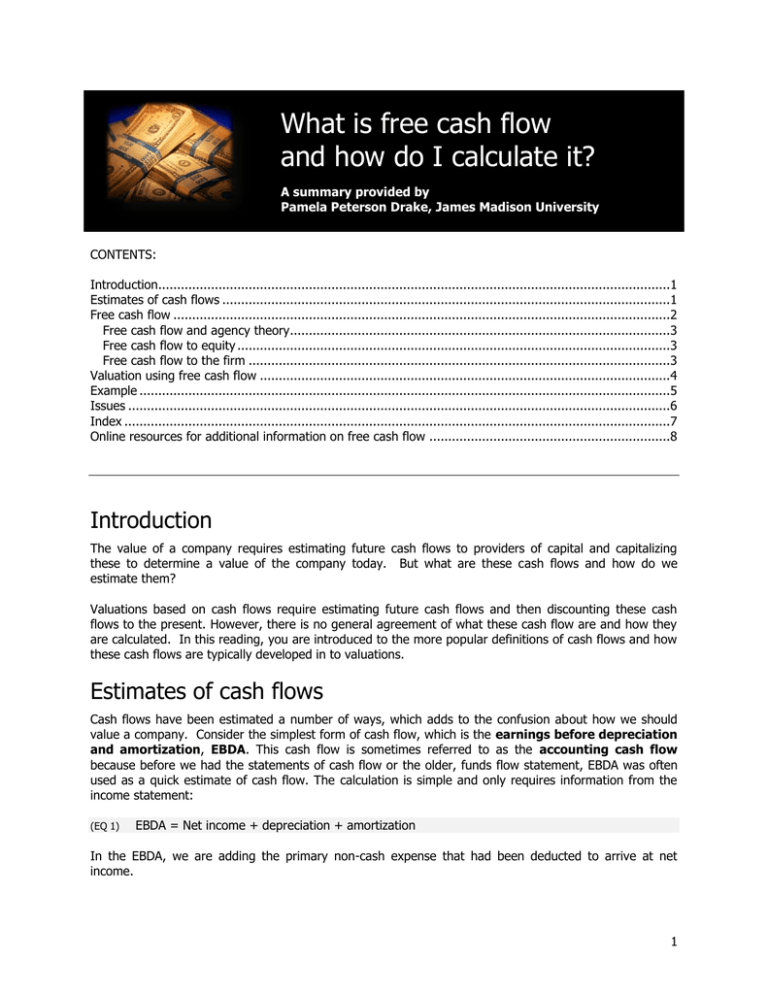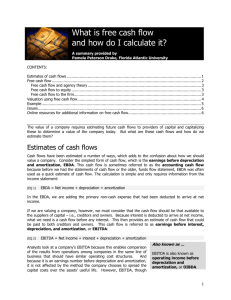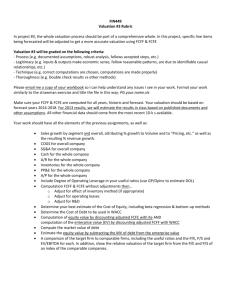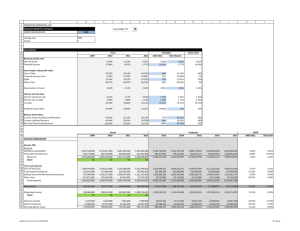What is free cash flow and how do I calculate it?
advertisement

What is free cash flow and how do I calculate it? A summary provided by Pamela Peterson Drake, James Madison University CONTENTS: Introduction........................................................................................................................................1 Estimates of cash flows .......................................................................................................................1 Free cash flow ....................................................................................................................................2 Free cash flow and agency theory .....................................................................................................3 Free cash flow to equity ...................................................................................................................3 Free cash flow to the firm ................................................................................................................3 Valuation using free cash flow .............................................................................................................4 Example .............................................................................................................................................5 Issues ................................................................................................................................................6 Index .................................................................................................................................................7 Online resources for additional information on free cash flow ................................................................8 Introduction The value of a company requires estimating future cash flows to providers of capital and capitalizing these to determine a value of the company today. But what are these cash flows and how do we estimate them? Valuations based on cash flows require estimating future cash flows and then discounting these cash flows to the present. However, there is no general agreement of what these cash flow are and how they are calculated. In this reading, you are introduced to the more popular definitions of cash flows and how these cash flows are typically developed in to valuations. Estimates of cash flows Cash flows have been estimated a number of ways, which adds to the confusion about how we should value a company. Consider the simplest form of cash flow, which is the earnings before depreciation and amortization, EBDA. This cash flow is sometimes referred to as the accounting cash flow because before we had the statements of cash flow or the older, funds flow statement, EBDA was often used as a quick estimate of cash flow. The calculation is simple and only requires information from the income statement: (EQ 1) EBDA = Net income + depreciation + amortization In the EBDA, we are adding the primary non-cash expense that had been deducted to arrive at net income. 1 If we are valuing a company, however, we must consider that the cash EBITDA is also known as flow should be that available to the suppliers of capital – i.e., creditors operating income before and owners. Because interest is deducted to arrive at net income, depreciation and what we need is a cash flow before any interest. This then provides an amortization, or OIBDA. estimate of cash flow that could be paid to both creditors and owners. This cash flow is referred to as earnings before interest, depreciation, and amortization, or EBITDA: (EQ 2) EBITDA = Net income + interest + depreciation + amortization Analysts look at a company’s EBITDA because this enables comparison of the results from operations among companies in the same line of business that should have similar operating cost structures. And because it is an earnings number before depreciation and amortization, it is not affected by the method the company chooses to spread the capital costs over the assets’ useful life. However, EBITDA, though useful in some applications, is does not fully reflect the cash flows of a company. The requirement that companies report cash flow information in the statement of cash flows provides information that is useful in financial analysis and valuation. This statement requires the segregation of cash flows by operations, financing, and investment activities. A key cash flow in both analysis and valuation is the cash flow for/from operating activities. This cash flow is calculated by adjusting net income for non-cash expenses and income, as well as for changes in working capital accounts. This latter adjustment is used to convert the accrual-based accounting into cash-based accounting. The calculation uses information from both the company’s income statement and its balance sheet: (EQ 3) CFO = Net other non-cash increase in + depreciation + amortization + income charges (income) net working capital Net working capital is defined as: (EQ 4) Net working capital = Current assets – current liabilities Therefore, if net working capital increases, this is an offset to cash flow from operations, whereas if net working capital decreases, this is an enhancement of the cash flow from operations. Cash flow from operations is a key indicator of a company’s financial health, because without the ability to generate cash flows from its operations, a company may not be able to survive in the future: cash flows are the lifeblood of a company. Free cash flow It has always been recognized that cash flow, no matter how we calculated it, does not necessarily reflect what was available for the suppliers of capital (that is, creditors and owners). An alternative cash flow, known as free cash flow (FCF), is useful in gauging a company’s cash flow beyond that necessary to grow at the current rate. This is because a company must make capital expenditures to continue to exist and to grow and FCF considers these expenditures. In analysis and valuation, the essence of free cash flow is expressed as cash flow from operations, less any capital expenditures necessary to maintain its current growth: (EQ 5) Free cash flow = CFO - capital expenditures necessary to maintain current growth 2 Unfortunately, the amount that a company spends on capital expenditures necessary to maintain current growth is not something that can be determined from the financial statements. Therefore, many analysts revert to using the earlier calculation of free cash flow, using the entire capital expenditure for the period: (EQ 6) Free cash flow = CFO - capital expenditures This represents the financial flexibility of the company; that is, these funds represent the ability to take advantage of investment opportunities beyond the planned investments. However, because capital expenditures for many companies tend to be “lumpy” (that is, vary significantly from year to year), caution should be applied in interpreting the year-to-year variations in FCF that are due solely to the “lumpiness” of cash flows. Free cash flow and agency theory Michael Jensen developed a theory of free cash flow in an agency context.1 The theory focused on the availability of free cash flow and the agency costs associated with this availability. His theory associated agency costs with free cash flow: if a company has free cash flow, this cash flow may be wasted and, hence, is underutilized – resulting in an agency cost. There has been research and debate as to whether there are truly costs to free cash flow, yet his theory did shift focus away from earnings and towards to the concept of free cash flow. Free cash flow to equity In the valuation of the equity of a company, we need to consider that owners, as the residual claimants, are affected by the debt financing of a company. Therefore, the free cash flow to equity (FCFE) is the FCF adjusted for the debt cash flows.2 The debt cash flow adjustment, or net borrowings, is: debt Net borrowing = new debt financing repayment The free cash flow to equity, starting with the cash flow from operations, is: (EQ 7) (EQ 8) FCFE = cash flow capital from operations expenditures net borrowing Another form of the calculation is to start with net income and then add non-cash charges (or subtract non-cash income), such as depreciation, amortization, charges for the write-down of assets, and deferred income taxes: (EQ 9) FCFE = Net + non-cash capital net + income charges (income) expenditures borrowing Free cash flow to the firm Free cash flow to the firm (FCFF) is the cash flow available to all providers of capital. We calculate the FCFF by starting with cash flows from operations: (EQ 10) 1 FCFF = Cash flow capital + Interest 1- tax from operations rate expenditures Michael Jensen, “Agency Costs of Free Cash Flow, Corporate Finance, and Takeovers,” American Economic Review, 76, no. 2 (May 1986), pp. 323–329. 2 If the company has preferred stock and the company pays preferred dividends, the free cash flow to common equity (FCFCE) is the FCFE, less any preferred dividends. 3 Another approach is to begin with earnings before interest and taxes: (EQ 11) non-cash capital FCFF = EBIT 1 - tax + rate charges (income) expenditures increase in working capital Recognizing that: (EQ 12) EBIT 1 - tax = Net + Interest 1- tax rate income rate , we can re-write equation 11 in terms of net income: (EQ 13) FCFF = Net non-cash capital + Interest 1- tax + income rate charges (income) expenditures increase in working capital The FCFF is often referred to as the unlevered free cash flow because it is the cash flow before interest on debt is considered. We can reconcile the free cash flow to the firm with the free cash flow to equity by noting that the difference between the two are: Interest paid on debt, and Net new debt financing. In other words, (EQ 14) Free cash flow to the firm = FCFE + interest 1-tax rate expense - net borrowings Valuation using free cash flow The valuation of a company requires discounting the future cash flow to the present. The cash flows that we use in this valuation are forecasted free cash flows. The model that we use to determine a value today depends on the assumptions regarding the growth of the free cash flows. Let r indicate the appropriate cost of capital, let g represent the estimated growth rate and let t indicate the period. The value of a firm is calculated by choosing the appropriate model: Growth assumption Model General formula No growth Perpetuity Value = Constant growth Gordon growth model Value = Non-constant growth Discounted cash flow FCF r FCF1 r-g FCFt Value= t=1 r The appropriate cost of capital and free cash flow depend on what you are valuing: 4 In the valuation of equity, the cost of capital is the cost of equity and the free cash flow is the free cash flow to equity. In the value of the firm, the cost of capital is the weighted average cost of capital for the firm and the free cash flow is the free cash flow to the firm. For example, if you are valuing the equity of a company and are assuming that the free cash flows will grow at a constant rate indefinitely, then the appropriate formulation is: (EQ 15) Value of equity = FCFE1 re - g with re the cost of equity. If, on the other hand, you are valuing the entire firm and are assuming that the cash flows will grow at the rate of g1 for t1 periods and then g2 thereafter, the appropriate formulation is: (EQ 16) Value of the firm= FCFF0 (1+g) t + t=1 (1+rc ) t FCFF0 (1+g1 ) t1 (1+g2 ) t1 (1+rc ) rc -g2 t1 where rc indicates the weighted average cost of capital. Example Consider Lowe’s Companies’ 2005 fiscal year annual report. The following information is available from the company’s financial statements, with dollar amounts in millions: Source Item Cash flow from operations Net income EBIT [calculated as: $4,506 +158] Depreciation and amortization Other non-cash adjustments Change in working capital Capital expenditures [calculated as: $3,379 - 61] Net debt financing [calculated as: $1,031 – 633] Interest expense Tax rate (estimated as $1,735 / $4,506) Amount in millions $3,842 $2,771 $4,664 $1,051 $133 $113 $3,318 $380 $158 38.5% Income statement Balance sheet Statement of cash flows √ √ √ √ √ √ √ √ √ √ √ Therefore, assuming that all capital expenditures are necessary for maintaining the current growth, the free cash flows for 2005, in millions, are: Free cash flow Equation Calculation Free cash flow to equity EQ 8 $3,842 – 3,318 + 380 = $904 EQ 9 $2,771 + 1,051 + 133 - 3,318 – 113 + 380 = $904 EQ 10 $3,842 + 158 (1 - 0.385) - 3,318 = $621 EQ 11 $2,868 + 1,051 + 133 – 3,318 - 113 = $621 EQ 13 $2,771 + 1,051 + 133 + 158 (1-0.385) – 3,318 - 113 = $621 Free cash flow to the firm 5 EQ 14 $904 + 158 (1 – 0.385) - 380 = $621 Suppose Lowe’s cash flows are expected to grow at rate of 21 percent for the next five years and then 4.5 percent thereafter. If the cost of equity is 8.5 percent and the weighted average cost of capital is 7.5 percent, the valuation of the company and of the equity is calculated as $55 billion and $44 billion respectively: in millions Value of the firm Value of equity FCF1 $751 $1,094 FCF2 $909 $1,324 FCF3 $1,100 $1,601 FCF4 $1,331 $1,938 FCF5 $1,611 $2,345 Horizon value $67,328 $61,256 Value today $49,422 $43,891 Issues There are a number of issues that arise in calculating and using free cash flows in valuation. These issues include: THERE ARE MANY DEFINITIONS OF FREE CASH FLOW. We look at definitions of free cash flow, free cash flow to equity, and free cash flow to the firm. But there are actually many different calculations to represent these cash flows and, to add to the confusion, many are simply referred to as free cash flow. THE CURRENT PERFORMANCE ASSUMED REPRESENTATIVE. Estimating free cash flow for future periods using current financial information presumes that the current performance is representative of the company and its ability to generate cash flows. Variation in capital expenditures from year to year, combined with the typical variability in net income, suggest that a better benchmark may use some type of averaging of cash flows from several periods, not just one fiscal period. THE BENEFIT OF FREE CASH FLOW IS STILL DEBATED. While free cash flow provides financial flexibility, it also provides temptation to invest in non-value adding projects. VALUES ARE SENSITIVE TO THE ASSUMPTIONS AND ESTIMATES. The value estimated using free cash flows should be evaluated with respect to the sensitivity of the estimate to the specific calculation of free cash flow, the assumptions regarding growth rates, and the assumptions imbedded in the calculation of the appropriate cost of capital. 6 Index Accounting cash flow, 1 Earnings before depreciation and amortization, 1 Earnings before interest, depreciation, and amortization, 2 EBDA. See Earnings before depreciation and amortization EBITDA. See Earnings before interest, depreciation, and amortization FCF. See Free cash flow FCFCE. See Free cash flow to common equity FCFE. See Free cash flow to equity FCFF. See Free cash flow to the firm Free cash flow, 2 Free cash flow to common equity, 3 Free cash flow to equity, 3 Free cash flow to the firm, 3 Net working capital, 2 OIBDA. See Operating income before depreciation and amortization Operating income before depreciation and amortization, 1 Unlevered free cash flow, 4 7 Online resources for additional information on free cash flow 1. 2. 3. 4. 5. Damadoran, Aswath, “Firm Valuation: Cost of Capital and APV Approaches,” Chapter 15. Damadoran, Aswath, “Free Cash Flow to Equity Discount Models, Chapter 14. Mills, John, Lynn Bible, and Richard Mason. “Defining Free Cash Flow,” The CPA Journal, 2002. Motley Fool, Foolish Fundamentals: Free Cash Flow. Tarter, John, Federal Reserve Bank of Cleveland, Supervision & Regulation Department, “EBITA a Useful Cash-Flow Tool, But No Substitute for Good Judgment.” 6. Value-Based Management.net, “Earnings Before Interest, Taxes, Depreciation and Amortization.” 8






